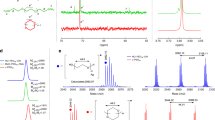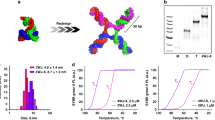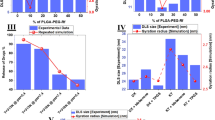Abstract
Platinum nanoparticles stabilized by linear polyethyleneimine (LPEI) were prepared by the liquid-phase reduction of chloroplatinic(IV) acid with sodium borohydride. The average radii of particles were 3.26 and 1.76 nm when the molecular weights of LPEI were 25 000 and 2150, respectively. These nanoparticles were well dispersed in water in the pH range of 1–6. Branched polyethyleneimine also provided nanoparticles that dispersed in water in the pH range of 0–8. Linear poly(ethyleneimine-co-N-methylethyleneimine) gave nanoparticles that dispersed in water in the pH range of −1 to 15. The dispersibility of the nanoparticles decreased with increasing content of the N-methyl group.
Similar content being viewed by others
Introduction
Platinum is known as a highly durable and high-activity catalyst1, 2, 3, 4 in both synthetic organic chemistry and environmental science and is widely used in these scientific areas. Platinum nanoparticles (PtNPs) are also used as an environmental catalyst for cleaning the exhaust gases from automobiles and factories.5, 6 To date, many PtNPs have been prepared using various methods that fall into three main categories: reduction of hexachloroplatinic(IV) acid in the presence of poly(methacrylic acid);7 reduction of hexachloroplatinic(IV) acid in the presence of polyvinylpyrrolidone;8 and reduction of potassium tetrachloroplatinate(II) in the presence of polyamidoamine dendrimers.9 In the first method, PtNPs are prepared by the chemical modification of the acrylic acid group to platinum during the reduction process. The yield of PtNPs is low when the particle size distribution is narrow. In the second method, PtNPs are prepared by the coordination of the carbonyl group to platinum during the reduction process. The PtNPs are formed with a high yield and dispersed in water in the pH range from 2 to 7. In the third method, PtNPs are prepared by the modification of dendrimers. The PtNPs show low stability under acidic conditions.
When the PtNPs are applied to a catalyst, they are often supported on the surface of silica or alumina gel. In recent years, platinum catalysts have been prepared by deposition on the surface of a mesoporous silica support that is formed in a honeycomb structure by the accumulation of long silica channels.10 The PtNP-supported mesoporous silica catalyst is prepared by two pathways. The first pathway consists of the immersion of mesoporous silica in a solution of PtNPs. Alternatively, the first pathway can be performed by a sol-gel reaction of alkoxysilanes in the presence of a surfactant and PtNPs under acidic conditions to assist in the hydrolytic polycondensation of alkoxysilanes. In the second pathway, the preparation of mesoporous silica and the installation of PtNPs are performed in a parallel manner, which means that the PtNPs are deposited on the silica surface during the formation of the silica gel. Because such a sol-gel reaction is performed under acidic conditions, the PtNPs have to be stable at a low pH, such as a pH of <1. Polyvinylpyrrolidone-modified PtNPs are disadvantageous for the preparation of platinum–silica catalysts because of their low stability under acidic conditions, leading to precipitation of the platinum metal that is not supported on the surface of the silica gel.10 The low stability of polyvinylpyrrolidone-modified PtNPs is due to the low stability of the coordination of the pyrrolidone moiety to platinum under acidic conditions. For the preparation of such PtNPs, a chemical modifier stronger than polyvinylpyrrolidone is necessary. For example, the chemical modification of platinum using the coordination of the nitrogen atom is one of the candidate approaches for forming a stronger coordination bond with platinum compared with that formed by coordination with an oxygen atom.11
In this work, therefore, nitrogen-containing polymer chemical modifiers were selected for the preparation of PtNPs. Namely, the preparation of PtNPs using linear polyethyleneimine (LPEI), branched polyethyleneimine (BPEI) and a copolymer of ethyleneimine and N-methylethyleneimine (poly(EI-co-NMEI)) was studied according to Scheme 1.
Experimental Procedure
Reagents
Hexachloroplatinic(IV) acid hexahydrate, BPEI (MW 1800), sodium borohydride, formic acid, formaldehyde and ethanol (Wako Pure Chemical Co, Ltd, Tokyo, Japan) were used as received. Poly(2-ethyl-2-oxazoline) (MW 5000) and LPEI (MW 25 000) (Alfa Aesar Co, Ltd, Ward Hill, MA, USA) were also used as received.
Preparation of ligand agents
LPEI (MW 2150) was synthesized by the hydrolysis of poly(2-ethyl-2-oxazoline) (MW 5000) according to the method described in the literature.12 Poly(EI-co-NMEI)s (17–100% of methylation) were synthesized by Eschweiler–Clarke reaction of LPEI (MW 2150) using formaldehyde and formic acid according to the method described in the literature.13
Preparation of LPEI (MW 25 000)-protected PtNPs
LPEI (MW 25 000) (596 mg, 0.024 mmol) and water (80 ml) were charged in a 100-ml flask and heated at 60 °C for 10 min. After cooling to 25 °C, chloroplatinic(IV) acid hexahydrate (594 mg, 1.25 mmol) was added. An excess amount of sodium borohydride was then added, and the solution was heated at 90 °C for 1 h Solid materials were removed by filtration, and the filtrate was added to ethanol. The precipitate was recovered by filtration and subjected to evaporation to provide LPEI-protected PtNPs as a brown powder.
Preparation of LPEI (MW 2150)-protected PtNPs
LPEI (MW 2150) (267 mg, 0.12 mmol), ethanol (80 ml) and chloroplatinic(IV) acid hexahydrate (25.5 mg, 0.052 mmol) were charged in a 100-ml flask and heated at 90 °C for 4 h After cooling to 25 °C, an excess amount of sodium borohydride was added. The solid materials were removed by ultrafiltration. The filtrate was concentrated and poured into hexane. The precipitate was recovered by filtration and subjected to evaporation to provide LPEI-protected PtNPs as a brown powder.
Preparation of LPEI/BPEI-protected PtNPs
LPEI (MW 2150) (143.2 mg, 0.067 mmol), BPEI (154.8 mg, 0.086 mmol) and ethanol (80 ml) were combined. Chloroplatinic(IV) acid hexahydrate (10.7 mg, 0.022 mmol) was added, and the solution was subjected to heating at 90 °C for 4 h. After cooling to 25 °C, an excess amount of sodium borohydride was added, and the solution was then heated at 90 °C for 10 min. The solid materials were removed by filtration. The filtrate was subjected to ultracentrifugation, ultrafiltration and drying under a reduced pressure to provide LPEI/BPEI-protected PtNPs as a highly viscous black liquid.
Other LPEI/BPEI-protected PtNPs were prepared using LPEI (MW 2150) (91.7 mg, 0.043 mmol) and BPEI (210.3 mg, 0.12 mmol) or BPEI (306.4 mg, 0.17 mmol) only.
Preparation of poly(EI-co-NMEI)-protected PtNPs
Poly(EI-co-NMEI) (N-methyl 17%) (152 mg, 0.067 mmol) and ethanol (80 ml) were combined. Chloroplatinic(IV) acid hexahydrate (15.0 mg, 0.031 mmol) was added, and the solution was subjected to heating at 90 °C for 4 h. After cooling to 25 °C, an excess amount of sodium borohydride was added, and the solution was then heated at 90 °C for 10 min. After filtration, ultrafiltration and drying under a reduced pressure, poly(EI-co-NMEI)-protected PtNPs were obtained as a brown liquid.
Other poly(EI-co-NMEI)-protected PtNPs were prepared by using poly(EI-co-NMEI)s with different levels of methylation: 40% (151 mg, 0.062 mmol), 56% (149 mg, 0.059 mmol), 88% (131 mg, 0.047 mmol) and 100% (151 mg, 0.053 mmol).
Evaluation of the dispersibility of polymer-protected PtNPs
PtNPs were mixed in a vial container with hydrochloric acid or a sodium hydroxide solution, and the mixtures were adjusted to an objective pH range of −1 to 15. The samples were left to stand at room temperature, and the state of the solution was evaluated visually.
Results and Discussion
Preparation of LPEI-protected PtNPs
We confirmed the preparation of PtNPs based on the color change of the solution from transparent to black as the duration of heating was increased. The results of the preparation of LPEI-protected PtNPs are summarized in Table 1. LPEI (MW 25 000)-protected PtNPs (no. 1) were obtained with a yield of 691 mg. Because the platinum content of PtNPs was measured by thermogravimetry analysis to be 14.7%, the percentage of the reactivity of hexachloroplatinic(IV) acid was calculated as 45.4%. The infrared spectrum is shown in Figure 1. The spectrum showed absorption bands due to νOH, νCH, δNH, δCH and νCN, which belong to the ethylenediamino group of PtNPs. The differential thermal-analysis thermogravimetry under an air atmosphere, as shown in Figure 2, showed a small endothermic peak at approximately 300 °C and a large exothermic peak at approximately 400 °C with weight losses, and the residue at 1000 °C was platinum. In the ultraviolet-visible absorption spectrum of LPEI (MW 25 000)-protected PtNPs in water, the absorption peak at 262 nm due to hexachloroplatinic(IV) acid disappeared, which supports the hypothesis that platinum(IV) ion was reduced to platinum(0). The LPEI (MW 25 000)-protected PtNPs were mixed with hydrochloric acid or sodium hydroxide solution in order to observe the stability under various pH values as shown in Figure 3. The nanoparticles were stable and well dispersed in water in the pH range 1–6, while they precipitated when the pH was <1 or >7.
In contrast, LPEI (MW 2150)-protected PtNPs (No. 2) were obtained with a yield of 52.2 mg. The content of platinum and the percentage of the reactivity of hexachloroplatinic(IV) acid were 18.1 and 84.4%, respectively. These nanoparticles were well dispersed in methanol, ethanol and water in the pH range of 1–6.
The transmission electron microscopy images of LPEI-protected PtNPs nos. 1 and 2 are shown in Figure 4. The average sizes of the nanoparticles are summarized in Table 2. The size of PtNP was evaluated by measuring the diameter of nanoparticles in the transmission electron microscopy images. The average sizes of PtNPs nos. 1 and 2 were 3.26±0.45 and 1.76±0.52 nm, respectively. These data suggest that the diameter of PtNPs is dependent on the molecular weight of LPEI.
Preparation of LPEI/BPEI-protected PtNPs
LPEI/BPEI-protected PtNPs were prepared using LPEI and BPEI as protecting polymers, and the results of the preparation are summarized in Table 3. The mass ratio of LPEI and BPEI polymer, LPEI:BPEI, showed values of 5:5, 3:7 or 0:10. The LPEI/BPEI-protected PtNPs were obtained in 20.1 mg (no. 3), 13.6 mg (no. 4) and 9.1 mg (no. 5), whereas the platinum contents were 10.9% (no. 3), 28.2% (no. 4) and 27.9% (no. 5). The platinum yield was calculated as 20.5% (no. 3), 33.9% (no. 4) and 22.5% (no. 5). The LPEI/BPEI-protected PtNPs were a highly viscous black liquid. These nanoparticles were dispersed in water in the pH range of 0–8 or 0–9. The secondary and tertiary nitrogen atoms in polyethyleneimine established the stronger coordination to the platinum atoms to increase the pH range of dispersion in water. In addition, the stable pH range for the dispersion of PtNPs could be controlled easily by modifying the amount of tertiary nitrogen atoms in the polyethyleneimine chain. The average sizes of LPEI/BPEI-protected PtNPs were 1.64±0.21 nm (no. 3), 3.09±0.72 nm (no. 4) and 1.74±0.20 nm (no. 5); however, there was no trend for the particle size of PtNPs.
Preparation of poly(EI-co-NMEI)-protected PtNPs
To confirm the effect of the introduction of tertiary nitrogen atoms in the polyethyleneimine chain, some nitrogen atoms in LPEI were methylated by the Eschweiler–Clarke reaction to give poly(EI-co-NMEI) with various degrees of methylation. In this reaction, the methyl group derived from formaldehyde is introduced to nitrogen atoms in polyethyleneimine in approximately quantitative yield, and the degree of methylation is controlled by the molar ratio of formaldehyde to the corresponding structural unit of ethyleneimine in polyethyleneimine. Based on this property, poly(EI-co-NMEI)-protected PtNPs with 17, 40, 56, 88, and 100% N-methylations were prepared, and the results are summarized in Table 4. The following amounts of poly(EI-co-NMEI)-protected PtNPs were obtained: 6.3 mg (no. 6), 8.6 mg (no. 7) and 4.5 mg (no. 8), whereas the platinum contents were 13.5% (no. 6), 9.8% (no. 7) and 10.6% (no. 8). The platinum yield was calculated as 15.2% (no. 6), 15.1% (no. 7) and 8.5% (no. 8). When the N-methylations were 17, 40 and 56% (nos 6–8), the poly(EI-co-NMEI)-protected PtNPs were a viscous brown liquid and dispersed in hydrochloric acid or sodium hydroxide solution in the pH range of −1 to 15. In contrast, when the N-methylations were 88 and 100% (nos 9 and 10), brown solids were obtained that showed no dispersion in water or various organic solvents. In contrast, a black precipitate of platinum was formed when these poly(EI-co-NMEI)-protected PtNPs were mixed with aqueous ammonia. The average sizes of poly(EI-co-NMEI)-protected PtNPs were 2.17±0.40 nm (no. 6), 2.38±0.43 nm (no. 7) and 3.24±0.64 nm (no. 8). When the percentage of N-methylations of poly(EI-co-NMEI) increased, sizes of PtNPs increased accordingly.
The preparation of LPEI, BPEI or poly(EI-co-NMEI)-protected PtNPs can be summarized as follows: (1) the PtNPs are formed by the coordination of both secondary-amino nitrogen atoms and tertiary-amino nitrogen atoms. (2) The size of PtNPs decreases when a protecting polymer with small molecular weight is used. (3) The secondary-amino nitrogen atoms coordinate more rapidly and stiffly compared with the tertiary-amino nitrogen atoms to provide PtNPs. (4) The pH value required to disperse PtNPs under acidic conditions decreases when more tertiary-amino nitrogen atoms are introduced. (5) The pH value required to disperse nanoparticles under basic conditions increases with the introduction of tertiary-amino nitrogen atoms.
The size of PtNPs is affected by the molecular weight and the composition of secondary- and tertiary-amino nitrogen atoms in LPEI, BPEI and poly(EI-co-NMEI). The polyethyleneimines with low molecular weights coordinate to the platinum more rapidly than those with high molecular weights, producing smaller nanoparticles. Another factor that affects the size of PtNPs is the greater basicity of the tertiary-amino nitrogen atom compared with that of the secondary-amino nitrogen atom: when the LPEI, BPEI or poly(EI-co-NMEI)-protected PtNPs are dispersed in acidic media, the secondary-amino nitrogen atoms are protonated more easily than the tertiary-amino nitrogen atoms, and then, they separate from the nanoparticles, allowing the nanoparticles to coagulate as precipitates. In contrast, when the nanoparticles are dispersed in basic media, the relatively acidic secondary-amino nitrogen atoms would be neutralized more easily than the tertiary-amino nitrogen atoms, thus losing their ability to coordinate and facilitate the coagulation of nanoparticles as precipitates. As a result, the pH range to disperse nanoparticles stably in water is broadened by the moderate introduction of tertiary-amino nitrogen atoms into the protecting agent.
Conclusions
PtNPs stabilized by LPEI were prepared by the liquid-phase reduction of chloroplatinic(IV) acid with sodium borohydride. The particle sizes were 3.26 and 1.76 nm when the molecular weights of LPEI were 25 000 and 2150, respectively. These nanoparticles were well dispersed in water in the pH range of 1–6. BPEI also provided nanoparticles that dispersed in water in the pH range of 0–8. Linear poly(ethyleneimine-co-N-methylethyleneimine) produced nanoparticles that dispersed in water in the pH range of −1 to 15, with dispersion decreasing as the number of N-methyl groups increased. The dispersion of nanoparticles was well established by using smaller PtNPs, which were prepared from the protecting agent with lower molecular weights. The nanoparticles were also stabilized over a wide pH range by moderate mixing of the secondary- and tertiary-amino nitrogen atoms in the protecting agent.

A schematic figure describing the preparation of polymer-protected PtNPs.
References
Watabe, M. Kemikaru Enjiniyaringu. Chapter 53, 290–294 (Kagaku Kogyosha, Kanagawa, Japan, 2008).
Miyazaki, A. & Balint, I. Metal Nanoclusters in Catalysis and Materials Science: The Issue of Size Control eds Corain B., Schmid G., Toshima N., 301–305 (Elsevier, Amsterdam, Netherlands, 2008).
Xu, C., Pan, M., Tang, H., Mu, S. & Yuan, R. Research of methods for preparing platinum nanoparticles as catalist. Dianchi Gongye 11, 350–355 (2006).
Somorjai, G. A. ACS Symposium Series Nanotechnology and the Environment eds Karn B., Masciangioli T., Zhang W., Colvin V., Alivisatos P., 890, 210–219 (ACS, Washington, DC, USA, 2005).
Uozumi, Y. Kagaku 63, 44–46 (Kagaku Dojin,, 2008).
Gunji, T., Shimano, R., Arimitsu, K. & Abe, Y. Preparation and characterization of mesoporous silica thin films from polyethoxysiloxanes. J. Polym. Sci. Part A: Polym. Chem. 44, 2542–2550 (2006).
Mayer, A. B. R. & Mark, J. E. Colloidal platinum-polyacid nanocatalyst systems. Angew. Makromol. Chem. 259, 45–53 (1998).
Borodko, Y., Humphrey, S. M., Tilley, T. D., Frei, H. & Somorjai, G. A. Charge-transfer interaction of poly(vinylporrolidone) with platinum and rhodium nanoparticles. J. Phys. Chem. C. 111, 6288–6295 (2007).
Lang, H., May, R. A., Iversen, B. L. & Chandler, B. D. Dendrimer-encapsulated nanoparticle precursors to supported platinum catalysts. J. Am. Chem. Soc. 125, 14832–14836 (2003).
Chiba, Y., Shibata, H., Nagata, D., Gunji, T., Tamura, R., Kineri, T. & Nishio, K. Catalytic Materials for Energy, Green Processes and Nanotechnology eds Mou C., Dai S., Kung H. H., Liu J., 1217, Y08–Y24 (Cambridge University Press, Warrendale, PA, USA, 2010).
Suda, M., Nakagawa, M., Iyoda, T. & Einaga, Y. Reversible photoswitching of ferromagnetic FePt nanoparticles at room temperature. J. Am. Chem. Soc. 129, 5538–5543 (2007).
Jin, R. Jpn. Kokai Tokkyo Koho JP 51056 (2007).
Rahal, S. & Badache, L. An anomalous Eschweiler–Clarke reaction. Tetrahedron Lett. 32, 3847–3848 (1991).
Acknowledgements
This research was supported by CLUSTER (the second stage) of the Ministry of Education, Culture, Sports Science, and Technology, Japan.
Author information
Authors and Affiliations
Corresponding author
Ethics declarations
Competing interests
The authors declare no conflict of interest.
Rights and permissions
About this article
Cite this article
Imai, T., Abe, Y., Nishio, K. et al. Preparation of platinum nanoparticles that are dispersible in water over a wide pH range. Polym J 45, 540–544 (2013). https://doi.org/10.1038/pj.2012.173
Received:
Revised:
Accepted:
Published:
Issue Date:
DOI: https://doi.org/10.1038/pj.2012.173







